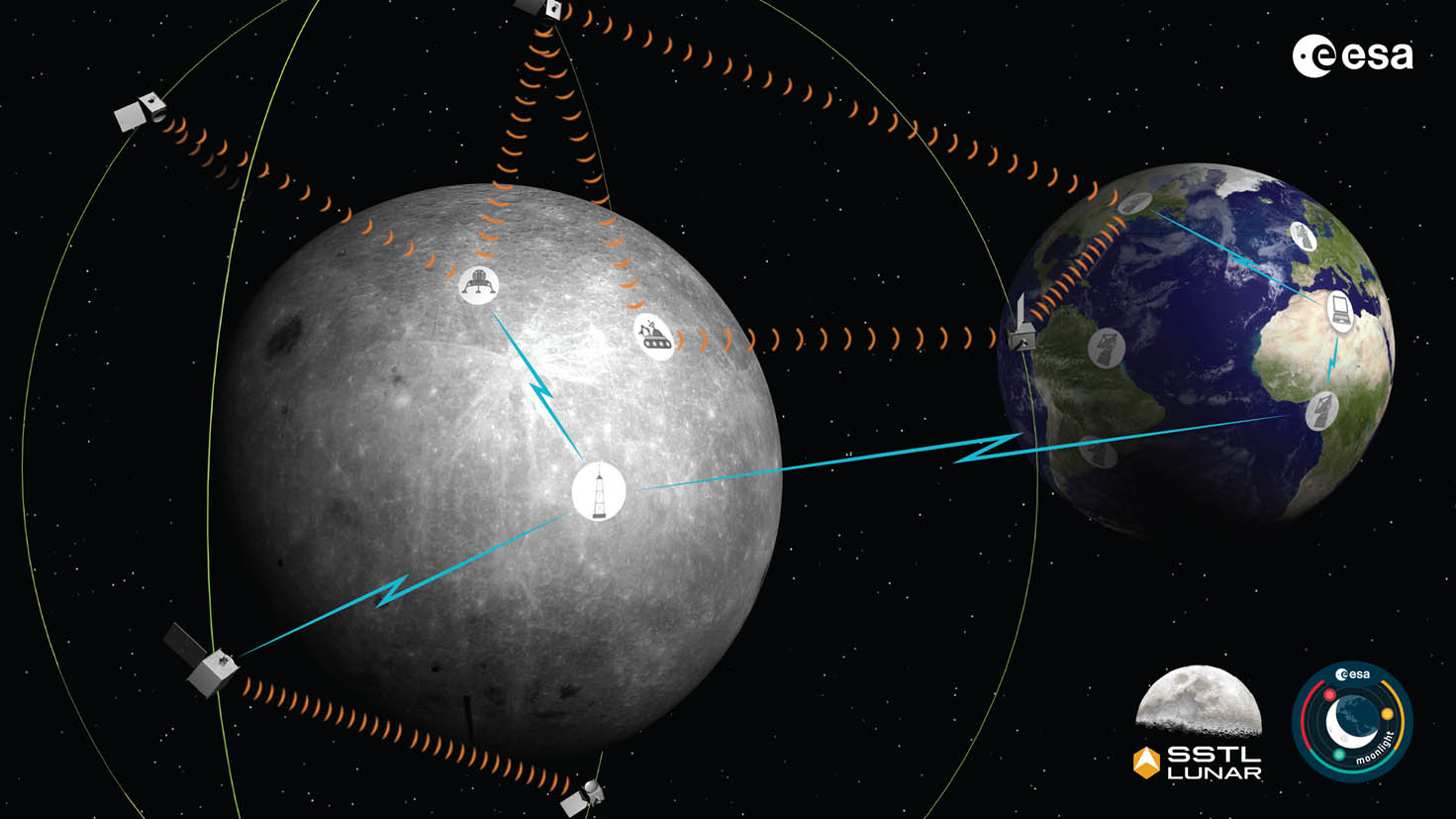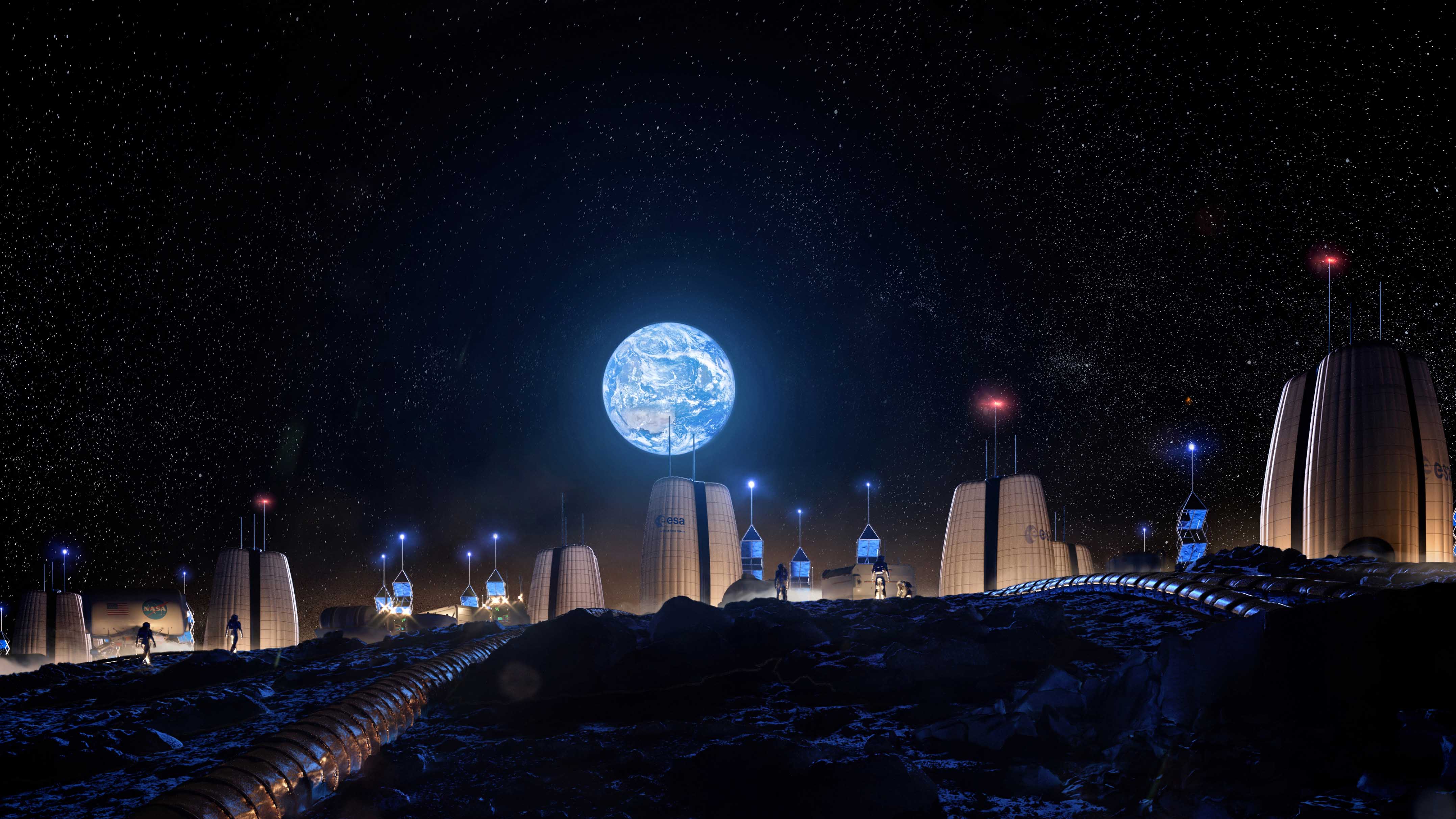Europe unveils plans to bring 'GPS' and Skype to the moon with satellites
Satellite navigation and teleconferencing could be available to lunar explorers by 2030.

The European Space Agency (ESA) has kicked off the development of a future satellite constellation that will orbit the moon and provide navigation and telecommunication services to lunar explorers.
If all goes according to plan, the new system could be in place in the late 2020s, only a few years after the expected landing of NASA's crewed Artemis 3 mission near the lunar south pole.
ESA believes that Earth's celestial companion is set to become a busy destination in the coming years, with commercial companies and nations from across the world all wanting a slice of the "eighth continent." The new constellation, called Moonlight, will make it easier and cheaper for a fledgling lunar economy to blossom, ESA officials suggested in a news conference on Thursday (May 20).
"Having a navigation and telecommunication network to relay what we learn on the moon back to Earth will be key for sustainability of future missions," Elodie Viau, ESA's director of telecommunications and integrated applications, said in the news conference. "You can imagine astronomers setting up observatories on the far side of the moon. And as we have all now become accustomed to virtual meetings, who knows? We could be doing Skype on the moon."
Related: NASA awards $370 million to private companies to aid moon exploration push
For now, ESA has awarded contracts to two European industrial consortia to study the feasibility of such an undertaking over the next year and a half and propose technical solutions for ESA to choose from.
"The idea is that this could be one of the projects that we take to the council of ESA member states in 2022 and propose for implementation," David Parker, ESA's director of human and robotic exploration, said in the news conference. "If that was the way forward, the project could start full steam ahead at the beginning of 2023, to ensure its operations within four or five years."
Breaking space news, the latest updates on rocket launches, skywatching events and more!
Challenges of lunar navigation
At the moment, supporting a single lunar mission requires a network of large Earth-based deep-space antennas that track and determine the position of an orbiter or a lander. But this way of doing things is slow and expensive, Paul Verhoef, ESA director of navigation, said in the news conference.
"There are very few installations around the world which can do that," he said. "You need a number of places working at the same time, and you need hours before you can actually have a reliable piece of information."
The accuracy of the positioning data is nowhere near comparable with what is available on Earth — between 0.3 and 3 miles (500 meters and 5 kilometers). In comparison, the accuracy of the US Global Positioning System (GPS) is between 1 and 16 feet (30 centimeters and 5 meters). Moreover, every lander has to carry an 88-lb. (40 kilograms) navigation subsystem that can process the incoming data and measure the distance from the surface to ensure a safe touchdown. With a lunar navigation satellite system in place, the future lunar vehicles would only need a simple receiver and an altimeter to make it down safely, Verhoef said.
"Shedding this weight and volume would then be used to put additional instruments on your lander and bring that to the moon," Verhoef added.

How can GPS reach the moon?
But first, ESA wants to take advantage of the swarms of navigation satellites that already orbit Earth. In addition to the United States' GPS network, there are three other global navigation satellite systems (GNSS) providing highly accurate positioning data to the planet’s inhabitants: Europe's Galileo, Russia's Glonass and China's Beidou. All of these satellites can deliver useful data to vehicles on the moon.
"These signals are sent by satellites to Earth, but they also bypass Earth and go further into space," said Verhoef. "We can combine the use of those signals in a receiver in order to determine the position of a vehicle on the moon."
A mission called the Lunar Pathfinder is already in the works that will test the novel GNSS receiver in orbit around the moon. The satellite, built by the UK-based Surrey Satellite Technology (SSTL), is scheduled to launch in 2024. SSTL also leads one of the consortia that will develop the proposal for the new constellation. The other is headed by Italy's Telespazio.

Three satellites in orbit
Verhoef said the lunar navigation constellation will likely consist of three or four satellites. Additional satellites might be added to beef up the communications aspect of the offering.
"With three or four satellites, we can already do quite a lot," Verhoef said. "The target we have at the moment is that the constellation would be able to allow an accuracy of 100 meters [330 feet] and probably better. We think that we might be able to get to 30-meter [100 feet] accuracy."
ESA expects the constellation will be operated by the private sector, which will sell the service to the agency and other customers in a similar fashion that SpaceX sells service missions and crew launches to the International Space Station.
"Creating this shared navigation and telecommunication network for the moon would undoubtedly act as a catalyst to inspire more exploration missions by not only ESA member states but international partners as well," SSTL managing director Phil Brownett said in the news conference. "We see it as significantly decreasing the cost and complexity of subsequent expeditions."
Follow Tereza Pultarova on Twitter @TerezaPultarova. Follow us on Twitter @Spacedotcom and on Facebook.
Join our Space Forums to keep talking space on the latest missions, night sky and more! And if you have a news tip, correction or comment, let us know at: community@space.com.

Tereza is a London-based science and technology journalist, aspiring fiction writer and amateur gymnast. Originally from Prague, the Czech Republic, she spent the first seven years of her career working as a reporter, script-writer and presenter for various TV programmes of the Czech Public Service Television. She later took a career break to pursue further education and added a Master's in Science from the International Space University, France, to her Bachelor's in Journalism and Master's in Cultural Anthropology from Prague's Charles University. She worked as a reporter at the Engineering and Technology magazine, freelanced for a range of publications including Live Science, Space.com, Professional Engineering, Via Satellite and Space News and served as a maternity cover science editor at the European Space Agency.
